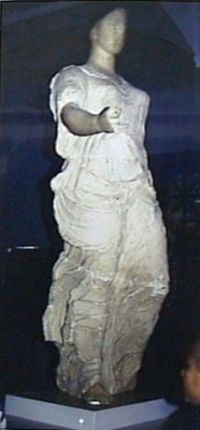Home - À et près de
THE VENUS OF MORGANTINA
The Venus of Morgantina is a statue from the homonymous archaeological site in Sicily, in the province of Enna. Venus is currently housed at the Paul Getty Museum in Malibu, California, but following a dispute that lasted for years between Italy and the United States, will be returned to Sicily in 2010. On 19 September 2009 the Head of Tourism of the Sicilian Region Nino Strano has announced that the finding, after an exhibition at the Quirinale, will find its permanent location to Aidone.
Description
The Venus (Aphrodite) of Morgantina is 2.20 m tall statue, and was carved between 425 BC and 400 BC, during the period in which he was assigned to Morgantina Kamarina, after the agreement of Gela (424 BC) wanted by Hermocrates of Syracuse.
The material is used to carve the marble used for the face and naked body parts, similar to the metopes of Selinus. The drapery is rather tufa, which was found to come from Sicily, according to tests carried out by experts from the quarry river Irminio.
Venus, unlike almost all other statues of the time, just finished the front, has worked on all sides, therefore, had to be exposed at a central point, probably in the agora of Morgantina. According to the hypothesis of many archaeologists and scholars, the statue represents the goddess Persephone and Demeter the mother because of a similtudine with a small terracotta statue at the Archaeological Museum of Aidone. The goddess Persephone was particularly venerated at the shrine center Morgantina and in almost all the coins minted by the Mint of Morgantina is always depicted in the straight. Indeed there is a similarity with the face of the statue of Persephone on some coins depicted veiled SIKELIOTAN series and especially with a gold coin (emistatere) minted in 212 BC when the polls turned against the Roman yoke and hosted for a time the army and the Punic Himilco Siceliot of Hippocrates. With his right hand seems to hold her torch, a symbol linked to the goddess Persephone Queen of the Underworld (Umberto Digrazia - Malcolm Bell).
History
The Venus of Morgantina was carved in the fifth century BC in Sicily, the site of Morgantina near Aidone (EN). The author was a direct disciple of Phidias, which operates in Magna Graecia.
The precious statue was stolen from Morgantina in the second half of the twentieth century, and sold to Paul Getty Museum, which acquired it in 1988 and since then exhibited in its halls as one of the most important finds. In the auction that led to the sale of Venus, held in London, she was paid 28 billion lire.
On 5 March 2001, the Court of Enna sentenced to two years in prison without the benefit of the law and to pay a penalty of 40 billion lire fence of Venus, an octogenarian Ticino, Renzo Canavesi: that was the first case in Italy a court applying a similar penalty for the illegal export of works of Italian art. Of the 40 billion redress sought by the Italian state, correspond to the 20 billion estimated value of the statue, and another 20 for moral damages.
According to the reconstruction of Enna magistrates, sentenced the Ticino would sell the Venus of Morgantina in the early eighties for $ 400,000 to a London company, the Robing Ltd Symes, who would later sold to Paul Getty Museum, in 1986, for 10 million dollars. Again the Court of Enna ascertained through a survey of petrographic statue, which is carved tufa comes from Sicily, thus anticipating the results of scientific investigations that the J. Paul Getty Museum has wanted to do before announcing the return of the statue to 'Italy.
source: wikipedia
Description
The Venus (Aphrodite) of Morgantina is 2.20 m tall statue, and was carved between 425 BC and 400 BC, during the period in which he was assigned to Morgantina Kamarina, after the agreement of Gela (424 BC) wanted by Hermocrates of Syracuse.
The material is used to carve the marble used for the face and naked body parts, similar to the metopes of Selinus. The drapery is rather tufa, which was found to come from Sicily, according to tests carried out by experts from the quarry river Irminio.
Venus, unlike almost all other statues of the time, just finished the front, has worked on all sides, therefore, had to be exposed at a central point, probably in the agora of Morgantina. According to the hypothesis of many archaeologists and scholars, the statue represents the goddess Persephone and Demeter the mother because of a similtudine with a small terracotta statue at the Archaeological Museum of Aidone. The goddess Persephone was particularly venerated at the shrine center Morgantina and in almost all the coins minted by the Mint of Morgantina is always depicted in the straight. Indeed there is a similarity with the face of the statue of Persephone on some coins depicted veiled SIKELIOTAN series and especially with a gold coin (emistatere) minted in 212 BC when the polls turned against the Roman yoke and hosted for a time the army and the Punic Himilco Siceliot of Hippocrates. With his right hand seems to hold her torch, a symbol linked to the goddess Persephone Queen of the Underworld (Umberto Digrazia - Malcolm Bell).
History
The Venus of Morgantina was carved in the fifth century BC in Sicily, the site of Morgantina near Aidone (EN). The author was a direct disciple of Phidias, which operates in Magna Graecia.
The precious statue was stolen from Morgantina in the second half of the twentieth century, and sold to Paul Getty Museum, which acquired it in 1988 and since then exhibited in its halls as one of the most important finds. In the auction that led to the sale of Venus, held in London, she was paid 28 billion lire.
On 5 March 2001, the Court of Enna sentenced to two years in prison without the benefit of the law and to pay a penalty of 40 billion lire fence of Venus, an octogenarian Ticino, Renzo Canavesi: that was the first case in Italy a court applying a similar penalty for the illegal export of works of Italian art. Of the 40 billion redress sought by the Italian state, correspond to the 20 billion estimated value of the statue, and another 20 for moral damages.
According to the reconstruction of Enna magistrates, sentenced the Ticino would sell the Venus of Morgantina in the early eighties for $ 400,000 to a London company, the Robing Ltd Symes, who would later sold to Paul Getty Museum, in 1986, for 10 million dollars. Again the Court of Enna ascertained through a survey of petrographic statue, which is carved tufa comes from Sicily, thus anticipating the results of scientific investigations that the J. Paul Getty Museum has wanted to do before announcing the return of the statue to 'Italy.
source: wikipedia



